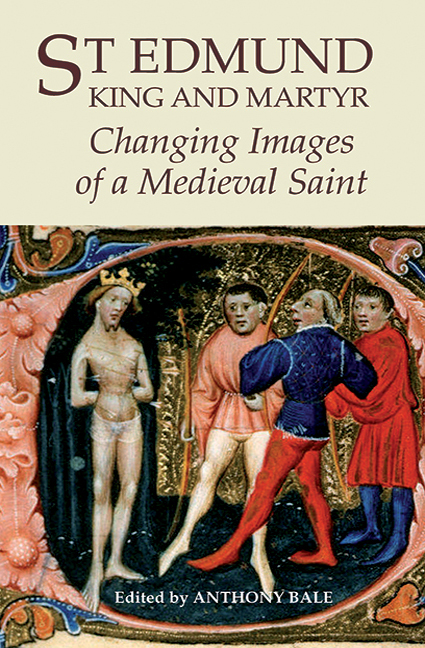Book contents
- Frontmatter
- Contents
- Preface
- List of Contributors
- List of Abbreviations
- Introduction: St Edmund's Medieval Lives
- 1 King, Martyr and Virgin: Imitatio Christi in Ælfric's Life of St Edmund
- 2 Chronology, Genealogy and Conversion: The Afterlife of St Edmund in the North
- 3 Geoffrey of Wells’ Liber de infantia sancti Edmundi and the ‘Anarchy’ of King Stephen's Reign
- 4 Music and Identity in Medieval Bury St Edmunds
- 5 Medieval images of St Edmund in Norfolk Churches
- 6 John Lydgate's Lives of Ss Edmund and Fremund: Politics, Hagiography and Literature
- 7 St Edmund in Fifteenth-Century London: The Lydgatian Miracles of St Edmund
- 8 The Later Lives of St Edmund: John Lydgate to John Stow
- Select Bibliography
- Index
- Miscellaneous Endmatter
1 - King, Martyr and Virgin: Imitatio Christi in Ælfric's Life of St Edmund
Published online by Cambridge University Press: 11 May 2017
- Frontmatter
- Contents
- Preface
- List of Contributors
- List of Abbreviations
- Introduction: St Edmund's Medieval Lives
- 1 King, Martyr and Virgin: Imitatio Christi in Ælfric's Life of St Edmund
- 2 Chronology, Genealogy and Conversion: The Afterlife of St Edmund in the North
- 3 Geoffrey of Wells’ Liber de infantia sancti Edmundi and the ‘Anarchy’ of King Stephen's Reign
- 4 Music and Identity in Medieval Bury St Edmunds
- 5 Medieval images of St Edmund in Norfolk Churches
- 6 John Lydgate's Lives of Ss Edmund and Fremund: Politics, Hagiography and Literature
- 7 St Edmund in Fifteenth-Century London: The Lydgatian Miracles of St Edmund
- 8 The Later Lives of St Edmund: John Lydgate to John Stow
- Select Bibliography
- Index
- Miscellaneous Endmatter
Summary
Then therefore [Pilate] delivered [Jesus] to them to be crucified. And they took Jesus and led him forth. And, bearing his own cross, he went forth to that place which is called Calvary, but in Hebrew Golgotha; Where they crucified him, and with him two others, one on each side, and Jesus in the midst. And Pilate wrote a title also; and he put it upon the cross. And the writing was JESUS OF NAZARETH, THE KING OF THE JEWS.
(John 19. 16–19, Douai-Rheims translation)Christian hagiography is intended to edify its audience and to promote the veneration of its subject by representing the saint in a way that will convince readers of his or her sanctity. Two main strategies are employed in pursuing these aims: recording the miracles that have been performed through the saint's mediation, and showing how the saint's life and death conformed to Christian expectations of a holy life and death. The latter can in turn be achieved by showing how closely the saint in question resembled other holy people. For the Christian, of course, the pre-eminent model of holy living and holy dying is Jesus of Nazareth, the man crucified under an inscription proclaiming him King of the Jews.
Following the conventions of the genre, early medieval hagiographers of St Edmund represented his life and especially his death in ways designed to demonstrate to the faithful that he was holy, that is to say Christ-like. This is recognized quite explicitly at the climax of the earliest vernacular life of St Edmund, produced in the late tenth century by the Anglo-Saxon monk Ælfric of Eynsham (c. 950–c. 1010) and preserved as part of his collection of Lives of Saints. As Edmund casts aside his weapons and accepts martyrdom, Ælfric describes him as ‘þæs Hælends gemyndig’ (‘mindful of the Saviour’) and specifically says that the king ‘wolde geæfenlæcan Cristes gebysnungum þe forbead Petre mid wæpnum’ (‘wanted to imitate Christ's example when he forbade Peter to fight with weapons’). This essay analyses Ælfric's construction of a Christ-like ideal of royal sainthood by examining the presentation of Edmund as imitating Christ in three different roles or identities: king, martyr and virgin.
- Type
- Chapter
- Information
- St Edmund, King and MartyrChanging Images of a Medieval Saint, pp. 27 - 44Publisher: Boydell & BrewerPrint publication year: 2009



